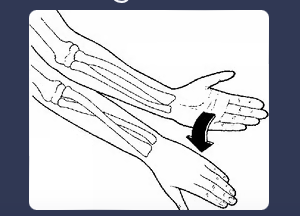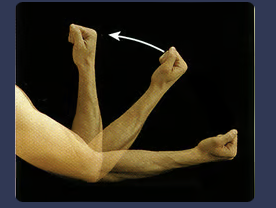Diaphoresis
excessive sweating usually due to a secondary condition
- common causes include: menopause, hyperthyroidism, and types of medications
Scoliosis
a deviation in the lateral curvature of the spine; curved spine
Kyphosis
increase in the thoracic curvature of the spine; hunchback
Epiphyses
the ends of long bones; made of cancellous bone
lordosis
exaggerated curvature of the lumbar spine; sway back
Osteoporosis
is the significant loss of bone mass and strength w/ an increased risk for fracture
Flat bones
include the sternum; main function is to provide vital organ protection
clonus
a rhythmic contraction of the muscle; occurs when the ankle is dorsiflexed or the wrist is extended
Fasciculations
involuntary twitching of muscle fibers groups
Contractures
are prolonged tightening of muscle groups
effusion
the pathologic escape of body fluid; the college iron of excessive fluid within the capsule of a joint
Tonus
state of readiness for muscles; produced by maintenance of some of the muscle fibers in a contracted state
Spasticity
a muscle with greater-than-normal tone
Atony
soft and flabby muscle tone
Flaccidity
a muscle that is limp and without tone
Bone Densitometry
used to detect bone density and can be used to assess the risk of fractures in osteoporosis
Arthrography
used to detect acute or chronic tears of joint capsule or supporting ligaments
Bone scans
used to detect metastatic and primary bone tumors, osteomyelitis, certain fractures, and aseptic necrosis
Athroscopy
used to visualize a joint
Telangiectasias
consist of red marks on the skin caused by the stretching of superficial blood vessels
Ecchymosis
aka bruises
purpura
consist of pinpoint hemorrhages into the skin
Urticariais
aka wheals or hives
Cherry angiomas
appear as bright red "moles"; common in the elderly, usually benign
solar lentigo
aka "liver spots"
Seborrheickeratoses
described as crusty brown "stuck on" patches
Xanthelasma
appears as yellowish, waxy deposits on the upper eyelids
Macules
is a flat, non palpable skin color change
papule
is an elevated, solid, palpable mass
vesicle
circumscribed, elevated, palpable mass containing serous fluid
pustule
a puss-filled vescicle
Addison's disease
patient will exhibit a bronze discoloration to their skin due to increased melanin production
Nodule

- a growth of abnormal tissue; can develop just below the skin, develop in deeper skin tissues, or internal organs
- a solid skin lesion more than 1 cm and usually involve deeper layers of skin
wheal (weal)

aka hives; superficial skin-colored or pale skin sweeping, usually surrounded by erythema
vesicle

- break easily and release fluid onto the skin
- is small, no more than 5 millimeters wide (if larger its called a bulla)
aka blister
Skin lesion
any area of skin that's abnormal from the skin around it; are very common and often the result of damage to the skin (ex: injury)
- very general (literally all others term fit under this umbrella term)
excoriation disorder
aka skin picking disorder or dermatillomania
main sign = can't stop picking skin
keloid

type of scar; is a smooth, hard growth that occurs as a result of excessive scar formation
exudate
is any fluid released by an organism through pores or a wound
pallor
- is a pale color of the skin that can be caused by illness, emotional shock, stress, stimulant use, or anemia
- check lips, lining of eyes, palms of hands, inside of mouth, and surface of tongue is pallor is suspected on patients with darker skin
petechiae
are round freckle-like spots that appear on the skin; occur due to bleeding from the capillaries that attached arteries to the veins
- may look like a rash and are red, brown, or purple
cyanosis
bluish tone to the skin, lips, or nails; occurs when the blood lacks oxygen
nosocomial
a hospital-acquired infection
purulent
consisting of, containing, or discharging pus
serous
any of various body fluids resembling serum, that are typically pale yellow or transparent; of a benign nature
jaundice
condition where the skin, sclera, and mucous membranes (inside of nose and mouth) turn yellow
pustule

a small blister or pimple on the skin containing pus (<1 cm)
turgor

the state of turgidity and resulting rigidity of cells or tissues, typically due to the absorption of fluid
- can be sign of hydration
serosanguineous
means contains or relates to both blood and the liquid part of blood (serum)
fissure
is small tear in the skin
edema
is swelling caused by too much fluid trapped in the body's tissues; can affect any part of the body but is most likely to show up in the legs and feet
sanguineous
fluid that resembles or contains blood
ulcer
are injuries to the skin and tissue below the skin that are due to pressure on the skin for a long time; usually found over a bony prominence
erythema
superficial Redding of the skin, usually in patches, as a result of injury or irrational causing dilation of the blood capillaries
crepitus
grating/cracking sound or sensation act a point of motion; usually a sign of a fracture
supination

rotation of the forearm and hand so that the palm faces forward or upward
abduction

movement of a body part away from the main axis
pronation

rotation of the hand and forearm so that the palm faces backwards or downwards
adduction

movement of a body part toward the main axis
hemiparesis
is one-sided muscle weakness
inversion

the condition of being turned inward; refers to the medial rotation of the foot frequently leading to a sprained ankle
circumduction

circular movement of a body segment, such as a limb
hemiplegia
paralysis of one side of the body (either the right or left side of the body); can be temporary or permanent
flexion

movement that decreases the angle of a joint
eversion

lateral rotation of the foot; the act of turning inside out
paralysis
the loss of the ability to move (and sometimes feel anything) in part or most of the body
cachexic/cachexia
aka wasting syndrome; is a condition that causes significant weight loss or muscle loss
- often affects people w/ sever chronic disease like advanced cancer and heart disease
extension

a type of movement that increases the angle of a joint in a sagittal plane (ex: straightening the knee)